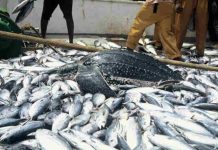
LAHORE: Contrary to expectations, the current account deficit soared by 37% month-on-month (MoM) in December 2018 to $1.7 billion as compared to $1.2 billion in November 2018, according to data released by State Bank of Pakistan on Thursday.
However, during the first half (July-December) of the current financial year 2018-19, the current account deficit declined by 4% year-on-year (YoY) to $8 billion compared to corresponding period of FY17-18 when it was recorded at $8.4 billion.
According to Topline Securities CEO Muhammad Sohail, “The current account deficit was much higher than our expectations of $1 billion.”
In brief comments, he added, “Further tightening in near-term through interest rate hike and rupee devaluation cannot be ruled out.
The government should also implement significant additional taxation measures in next weeks mini-budget to curtail both demand and the burgeoning fiscal deficit.”
The major rise in CAD has been fueled by a 12% ($574 million) MoM rise in total imports to $5.5 billion compared with $4.9 billion in the previous month.
Correspondingly, total exports also grew by 8% MoM ($188 million). The increase in current account deficit ($451 million) MoM is fueled by an increase in the overall trade deficit ($386 million).
Also, remittances increased by 5% or $81 million in December last year. During the first half of current FY18-19, 16% YoY decline in services imports helped curtail the overall trade deficit to $17.5 billion and current account deficit clocked in at $8.0 billion.
And the foreign direct investment (FDI) during the first half of current FY18-19 plunged 77.2% to $899.5 million compared to $3.950 billion in the corresponding period of 2017.
On a year-to-year basis, the FDI also plunged to $230 million in December 2018, against FDI of $2,740 million in the same month of the preceding year.
According to details, the net FDI from the United States fell from $407.5 million in July-December 2017-18 to negative $196.2 million in the same period of the current financial year.
Similarly, the net FDI from China also fell from $1,107.4 million in the corresponding period of 2017-18 to $754.2 million in the same period of the current FY18-19.
The net FDI from the Netherlands increased from $46.9 million to $53.5 million whereas, from the United Arab Emirates, it increased to $45.7 million from $5.8 million.
Likewise, the investment from Turkey also rose to $33.1 million in July-December 2018-19 from $8.8 million in the same period of the previous year.
To rein in demand, the central bank has allowed the rupee to depreciate by approximately 22% to Rs138.84 since December 2017 and made borrowing expensive by hiking the key interest rate by 425 basis points to 10% at end of November last year.
Pakistan’s current account deficit had swelled to a record high of $18 billion in FY17-18 mainly due to a surge in imports and less-than-forecast inflows.






